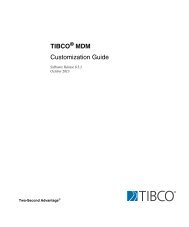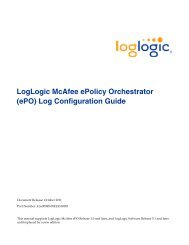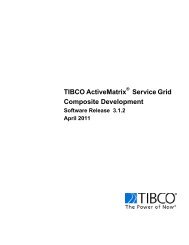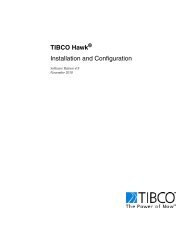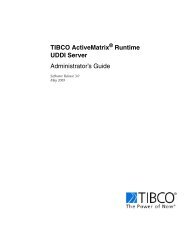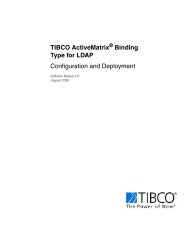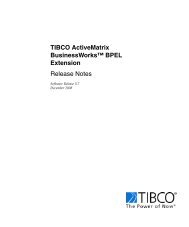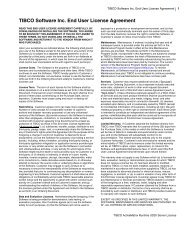TIBCO Spotfire Server 3.2.2 - TIBCO Product Documentation
TIBCO Spotfire Server 3.2.2 - TIBCO Product Documentation
TIBCO Spotfire Server 3.2.2 - TIBCO Product Documentation
You also want an ePaper? Increase the reach of your titles
YUMPU automatically turns print PDFs into web optimized ePapers that Google loves.
Load Balancing<br />
7 Load Balancing<br />
This chapter explains the concept of load balancing in a clustered environment, and<br />
how to set this up if you are running multiple <strong>Spotfire</strong> <strong>Server</strong>s in a cluster.<br />
7.1 Overview<br />
Load balancing is a technique for spreading the workload between two or more<br />
computers.<br />
In a clustered environment, each <strong>Spotfire</strong> client connects to a single network host, a<br />
load balancer, which redirects calls to an available <strong>Spotfire</strong> <strong>Server</strong>. It is important that<br />
the load balancer is able to redirect follow-up connections from the client to the same<br />
<strong>Spotfire</strong> <strong>Server</strong> for the duration of the user session (session affinity). It must also be<br />
able to detect when a <strong>Spotfire</strong> <strong>Server</strong> is unavailable, such as when maintenance is<br />
being performed, and stop directing traffic to that server. When the <strong>Spotfire</strong> <strong>Server</strong><br />
becomes available again, the load balancer must start directing calls to it again. If you<br />
wish to implement your own load balancing solution, these requirements must be met,<br />
with special emphasis on session affinity, without which communication between<br />
clients and servers will not work.<br />
The rest of this chapter assumes that you are using a load balancing solution based on<br />
Apache httpd with the mod_jk module enabled. Because the <strong>Spotfire</strong> <strong>Server</strong> is<br />
implemented as a Tomcat Service, and therefore supports the AJP (Apache JServ<br />
Protocol) protocol, this technology provides a good starting point for achieving a load<br />
balanced <strong>Spotfire</strong> system.<br />
To set up load balancing, configuration needs to be done on all the cluster nodes, as<br />
well as on the load balancer itself.<br />
7.2 Prerequisites<br />
• At least two <strong>Spotfire</strong> <strong>Server</strong>s need to be installed and configured.<br />
• Apache httpd and the mod_jk module need to be installed on the load balancer.<br />
• Optional: If NTLM authentication is used, the mod_auth_sspi module needs to<br />
be enabled in Apache httpd.<br />
7.3 Cluster Node Configuration<br />
Each <strong>Spotfire</strong> <strong>Server</strong> is prepared for communication with a load balancer on<br />
installation. You do not need to change anything on the servers. If you are well<br />
acquainted with load balancing and want to change any default settings, they are all set<br />
in the file server.xml. See the section “<strong>Server</strong>.xml” on page 135 for more information<br />
about this file.<br />
<strong>TIBCO</strong> <strong>Spotfire</strong>® <strong>Server</strong> <strong>3.2.2</strong> 59 (144)



